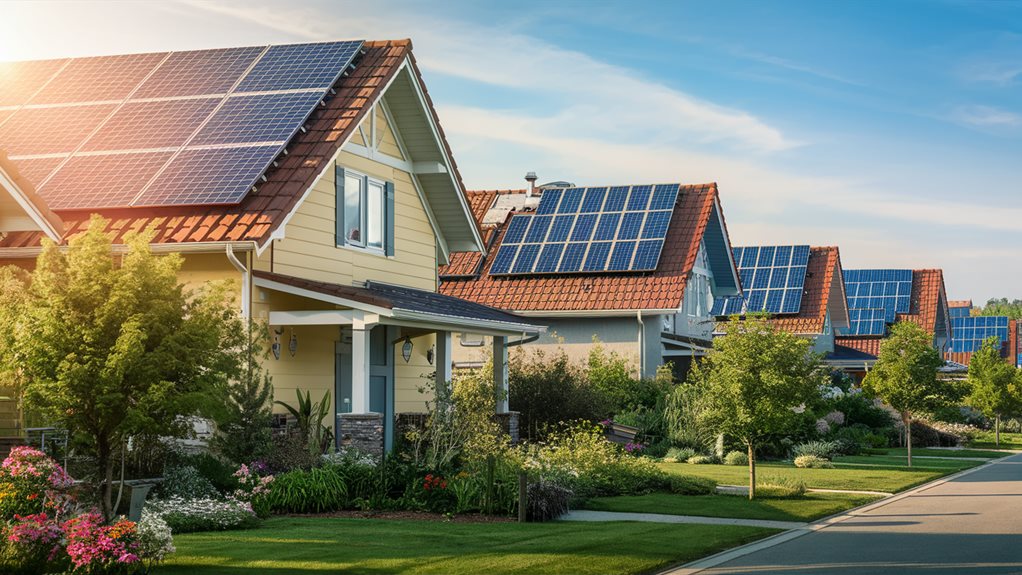Residential solar energy systems have emerged as a pivotal solution in reducing carbon footprints and promoting sustainable living. With the capability to generate electricity without direct emissions, these systems play an essential role in curbing air pollution and lessening reliance on fossil fuels. However, the journey from manufacturing to installation is not without environmental considerations. As we explore the intricate balance between immediate ecological benefits and the subtler, long-term impacts during production, one must consider the pivotal question: Are residential solar panels the definitive answer to our energy and environmental dilemmas, or merely a step in the right direction?
Expert Highlights
- Residential solar panels emit about 41 grams of CO2 per kWh, much lower than fossil fuels.
- Solar energy reduces particulate matter and nitrogen oxide emissions, enhancing air quality.
- Solar installations offset their manufacturing emissions in approximately three years.
- Solar panels generate zero direct emissions, promoting cleaner and healthier environments.
- Decreased reliance on fossil fuels improves human life expectancy and overall quality of life.
Definition of Solar Power
Solar power is a clean, renewable energy source that converts sunlight into electricity through processes like the photovoltaic effect and concentrated solar power systems.
Photovoltaic technology involves solar panels that use semiconductor materials to generate electric current when exposed to sunlight, while concentrated solar power systems utilize mirrors or lenses to focus sunlight, heating a fluid that drives a steam turbine. Almost half the solar power installed in 2022 was mounted on rooftops, highlighting the growing trend of residential solar adoption.
These technologies together form the foundation of solar power generation, offering sustainable solutions for reducing carbon emissions and advancing global energy needs.
Basics of Solar Energy
Harnessing the power of the sun represents a pivotal shift toward sustainable energy solutions. Solar power, defined as energy harvested from sunlight, is converted via photovoltaics (PV) or concentrated solar systems into electricity. Solar energy can be used to power household appliances, providing a reliable and renewable source of power for the home. This energy source serves residential, commercial, and utility-scale applications by exploiting the photovoltaic effect, where semiconductors transform sunlight into electric current, offering a versatile and renewable alternative to traditional fossil fuels.
Photovoltaic Technology Explored
Exploring the mechanisms behind solar energy, photovoltaic (PV) technology serves as a cornerstone in transforming sunlight into usable electricity. PV systems comprise semiconductor cells encapsulated within durable materials like glass or plastics to endure outdoor conditions. These cells form modules and panels, scalable into arrays to match energy demands. Efficiency rates reach up to 22.8% for residential systems, offering versatile and environmentally friendly energy solutions. By capturing the sun's energy for one hour, solar technology could potentially meet the world's electricity needs for an entire year, underscoring its vast potential as a sustainable power source.
Solar Power Generation Process
Amidst growing environmental concerns, solar power stands out as a sustainable energy solution. It is generated from sunlight via photovoltaic cells, which activate when sunlight strikes them. These cells convert photons into electrical energy through the photovoltaic effect. Solar panels, which are part of solar power systems, are constructed using silicon cells among other materials, to effectively convert sunlight into electricity. The produced direct current (DC) is transformed into alternating current (AC) by an inverter. Subsequently, the AC electricity is distributed for residential use.
Benefits
Residential solar energy offers numerous benefits, prominently including the reduction of carbon footprint, as solar panels typically generate electricity with substantially lower emissions compared to conventional fossil fuels. By embracing solar energy, homeowners contribute to improved air quality and subsequently enhance human life expectancy. Additionally, homeowners can experience considerable savings by lowering energy costs, seamlessly integrating solar power into existing structures to enhance grid stability and guarantee a steady supply of electricity. Furthermore, the installation of solar panels often leads to an increase in property value, as energy-efficient homes become more appealing to environmentally-conscious buyers.
Reducing Carbon Footprint
Solar energy greatly reduces the carbon footprint associated with residential electricity consumption. Residential solar panels are remarkably efficient in decreasing emissions:
- Emit about 41 grams of CO2 per kWh generated
- Life-cycle emissions are substantially lower than gas and coal alternatives
- Offset manufacturing emissions within three years through clean energy production
- Solar installations in urban areas consist of nearly 3% of the total, demonstrating the viability of integrating solar within city environments
- Potentially reduce California's carbon emissions by millions of metric tons
This demonstrates the transformative potential of residential solar.
Lowering Energy Costs
Harnessing solar energy offers significant financial benefits that extend well beyond initial investments. With average annual savings around $1,500, solar panels can save up to $90,000 over 25 years, contingent on usage and electricity rates. Augmented by federal tax credits, these systems can pay for themselves within eight years. Additionally, property values increase by over $9,000, further affirming solar's cost-lowering potential. Solar panels allow homeowners to lock in low, fixed electricity rates for 25 or more years, providing a hedge against rising utility costs.
Enhancing Grid Stability
Integrating solar energy into the power grid substantially enhances its stability and resilience. Solar energy addresses challenges in grid operation through:
- Improves frequency response: Advanced power electronics aid in quick adaptation to fluctuations.
- Reduces grid congestion: Distributed generation eases the load on transmission lines.
- Increases system robustness: Decentralized energy production mitigates outage impacts.
- Enhances voltage support: Inverters assist in voltage regulation and reliability.
- Manages intermittent output: Energy storage devices can store excess solar energy and deliver it when output is low, reducing the impact of solar energy's intermittent and variable nature on the grid.
Increasing Property Value
Frequently, the decision to install solar panels on residential properties is driven not just by environmental considerations, but also by their substantial financial benefits. Solar panels boost property values, with homes often selling 17% faster and for a premium. Homes with solar systems can command a significant premium in the market due to increased demand for energy-efficient homes and favorable state incentives. Increased demand for energy-efficient homes and favorable state incentives further elevate property values. Size, ownership type, and local market conditions also considerably influence this added value.
Lower Utility Grid Dependency
The adoption of residential solar energy systems considerably lowers reliance on utility grids by enabling homeowners to produce and store their own electricity, which fosters enhanced energy independence. By integrating with smart grids, solar technology facilitates real-time energy management, optimizing efficiency and reducing the consumption of fossil fuels. Solar panels generate electricity from sunshine, transforming it from direct current to alternate current, which seamlessly integrates into home electrical systems. The following table highlights key advantages of reduced grid dependency:
| Advantage |
Impact |
| Reduced Fossil Fuel Usage |
Decreases emissions and aligns with sustainability goals. |
| Enhanced Energy Independence |
Provides reliable power and reduces costs. |
| Integration With Smart Grids |
Optimizes energy distribution and efficiency. |
This shift not only supports environmental sustainability but also promotes economic benefits through decreased utility costs.
Reduced Fossil Fuel Usage
Harnessing solar energy has become an essential strategy in reducing fossil fuel usage and lowering dependency on traditional utility grids.
Contributing to the diminished use of non-renewable resources, solar panels lead to:
- Reduction in carbon emissions from 1,000 to 40 gCO2/kWh.
- Decreased reliance on coal-fired electricity.
- Financial savings through lower monthly utility bills.
- Ecosystem preservation by minimizing habitat destruction.
Enhanced Energy Independence
Integrating solar energy into residential power systems can substantially enhance energy independence by minimizing reliance on the utility grid.
An increased adoption rate, remarkably 4.96% of U.S. homes, reflects a broader economic shift towards solar. Households with incomes above $150,000 prioritize this change, fostering decarbonization and significant utility cost reductions.
Regional solar insolation plays a pivotal role, maximizing efficiency and financial feasibility across diverse locations.
Integration With Smart Grids
Increasingly, residential solar energy systems are being integrated with smart grids to enhance energy autonomy and reduce dependency on utility grids. This integration promises several advantages:
Real-time monitoring improves grid reliability by anticipating and resolving issues rapidly. Two-way electricity flow supports seamless incorporation of distributed energy resources. Energy storage systems balance generation with demand fluctuations. Advanced grid management systems predict and adjust supply and demand patterns efficiently.
FAQ
How Does Solar Panel Production Impact the Environment?
Solar panel production impacts the environment through high energy consumption, often relying on fossil fuels, considerable greenhouse gas emissions, and complex manufacturing processes. However, carbon emissions are markedly reduced compared to traditional energy sources over time.
What Is the Lifecycle Carbon Footprint of Solar Panels?
The lifecycle carbon footprint of solar panels ranges from 40 to 100 grams of CO2 per kilowatt-hour produced, primarily sourced from manufacturing processes, raw material extraction, and logistics, yet remains considerably lower compared to traditional energy sources.
How Are Solar Panels Recycled at the End of Their Life?
Solar panels are recycled through removal of external components, separation of materials, and recovery techniques. Advanced processes reclaim aluminum, glass, silicon, and valuable metals, thereby reducing landfill waste and supplying raw materials back to the solar industry.
Do Residential Solar Installations Affect Local Wildlife?
Residential solar installations pose minimal impact on local wildlife compared to large-scale solar farms. Utilizing already-built spaces, they reduce habitat disruption substantially, thereby minimizing noise and light pollution while supporting coexistence with local ecosystems effectively.
Are There Any Toxic Materials Used in Solar Panel Manufacturing?
Yes, toxic materials like lead and cadmium telluride are used in solar panel manufacturing. Efforts are underway to reduce these materials, improve recycling measures, and shift towards safer alternatives to mitigate environmental impacts.
Experts Final Thoughts
Residential solar panels offer significant environmental advantages by considerably reducing carbon emissions and enhancing air quality compared to fossil fuel-based energy sources. The solar power generation process is free from direct emissions, contributing to healthier living environments by lowering particulate matter and nitrogen oxide levels. Additionally, solar energy increases energy independence and diminishes dependency on utility grids and fossil fuels. These benefits support a more sustainable future while improving public health and life expectancy in affected communities.











